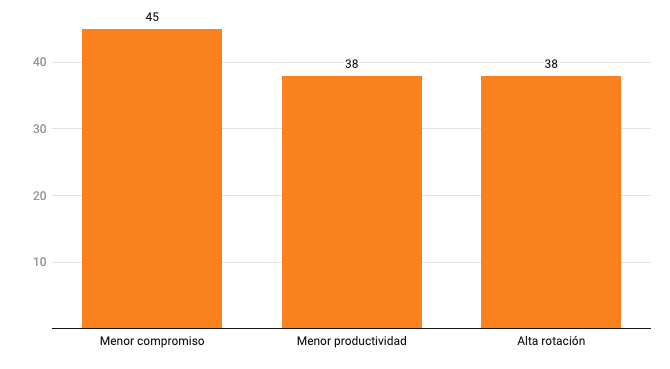For decades, the narrative of employment focused on salary; having a good position with good pay was, for many, the ideal professional destiny. Today, this vision has changed.
The new generations are no longer just looking for economic stability; they want to work and flourish in a place in which they can grow, learn, and have a balance with their personal lives.
What do experts say?
According to Manpower Group, young people prioritize professional development, continuous learning, and an organizational culture with a purpose.
This sets a new standard for companies that want to maintain their relevance in a competitive and changing environment.
According to OCC Mundial, the situation is more urgent if you take into account that 90 percent of collaborators in Mexico consider that occupational stress is a valid reason for changing jobs.
Among the main causes we find:
– Work-life imbalance
– Excessive working hours
– Inadequate leadership
Which translate into a lower commitment (45 percent), lower productivity (38 percent) and increasing rotation (38 percent).
Main consequences of the work-life imbalance?
In Mexico, 90% of people consider stress as a valid reason for quitting their job.

Graph: Axel Sánchez • Source: OCC Mundial • Created with Datawrapper
Percentage of people surveyed
“The new generations seek more than a place to work in: they want a place in which they can learn, be heard and have a real impact”, said Adriana Torres Nava, vice-president and leader of Capgemini’s Global Delivery Center (GDC) in México.

There is a work-life imbalance in jobs. | Special
“This is why, at the GDC, we design an experience that puts the collaborator at the center and evolves together with the collaborator’s aspirations”, she added.
Hybrid Work, a Strategic Business Model
Given this context, the GDC implemented a hybrid work model, together with programs for:
– Emotional well-being
– Psychological and medical support
– Internal mobility
– Inclusive culture
Additionally. It has agreements in place with universities in Aguascalientes and Jalisco with the objective of strengthening the competencies of the local ecosystem, integrating young talent by means of learning routes designed for facing the challenges of digital economy.
Its upskilling programs include:
– Technical certifications
– Leadership training
– Continuous training in English
– Project management and digital skills
Upskilling refers to the process of learning new skills or improving the existing ones for a current job position, with the objective of increasing productivity and efficiency in that role.
This approach has an impact beyond the individual level.
In the context of nearshoring where, according to D&M Abogados, Mexico could generate more than 1.1 million new jobs in the next three years, the GDC is emerging as a strategic platform that connects national talent with international projects.
Likewise, along with India, Poland, Morocco, and Egypt, the Mexico GDC is part of Capgemini’s network of global centers, which permits sharing best practices and strengthening global competitiveness.
“We are building a space in which employment has a purpose and Mexican talent can grow without limits; the future of labor is already here, and we firmly believe that it must be humane, flexible and have a purpose”, Torres Nava pointed out.

The GDC is emerging as a strategic platform that connects national talent with international projects. | Special
Today, more than ever, employment is not measured solely by payroll, but by experiences. And Capgemini’s GDC is demonstrating this from Mexico.
Employee turnover, a silent cost for companies
The costs of turnover, absenteeism and low productivity can represent between 20 and 200 percent of a collaborator’s annual salary.
Investing in well-being, leadership and organizational culture has become a key factor for business sustainability.
In an economic environment in which companies seek efficiency and profitability, nurturing talent is no longer just a question of ethics or reputation, but a financial decision.
According to Grant Thornton México, the costs associated with personnel turnover, burnout or lack of employee commitment represent one of the biggest risks for the financial results of an organization.
“Many companies continue seeing well-being or development initiatives as an expense. But the numbers say otherwise: not nurturing your team is much more expensive that investing in it”, pointed out Alejandra Ramírez, Human Capital Manager at Grant Thornton México.
According to international studies, replacing an employee can cost between 20 and 200 percent of said collaborator’s annual salary, depending on his level of specialization.
Added to this are losses due to low productivity, deterioration of the work environment and even customer experience can be affected.
Companies are anticipating greater movement of talent
Grant Thornton’s International Business Report (IBR) shows that 67 percent of companies at a global level expect an increase in their workforce, in comparison with the 58 percent that was registered in the last quarter.
This increase reflects an increased economic activity, but also more competition in attracting and retaining the most qualified profiles.

Salary is not the only priority for young people | Special
“Today, taking care of the talent is a part of financial planning. It involves measuring, anticipating and mitigating risks associated with the loss of know-how, unwanted turnover, and the burnout of key teams”, Alejandra Ramírez said.
What does nurturing talent entail?
Organizations that invest in their people do not necessarily require large budgets.
The key lies in taking concrete actions such as:
1.- Strengthening a close and empathetic leadership.
2.- Promoting flexible and sustainable programs.
3.- Investing in realistic professional development plans.
4.- Listening to the teams in an on-going basis.
“It is not about offering ping-pong tables, but about creating conditions that allow people to perform better, staying longer and building from their own potential”, Ramírez concluded.
In an increasingly dynamic and demanding hiring environment, the lesson is clear; nurturing talent is protecting the most valuable assets the organization has and this, more than a measure of culture, is an intelligent financial decision.



